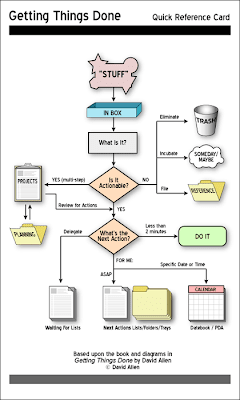Often on my time management courses I'm asked, "How do I manage e-mails?" or "My e-mail inbox is overflowing, how do I empty it?!?" It seems like we all have too many e-mails to handle and trying to manage e-mail takes up a good part of most office-workers days.
Here are a few considerations and e-mail tips influenced by Getting Things Done (GTD) and other time management systems:
Pick-Up Time and Breaks
No, not how quickly you can get lucky in a bar but how long it takes to stop doing an activity and then start again because of an interruption. It is much more efficient to e-mail in blocks than continuously throughout the day. It is not efficient to multi-task.
Here are a few considerations and e-mail tips influenced by Getting Things Done (GTD) and other time management systems:
Pick-Up Time and Breaks
No, not how quickly you can get lucky in a bar but how long it takes to stop doing an activity and then start again because of an interruption. It is much more efficient to e-mail in blocks than continuously throughout the day. It is not efficient to multi-task.
The counter balance to minimising pick-up time is that too long doing anyone activity will lead to a decrease in efficiency and an increase in mistakes, so regular breaks are essential. Even micro breaks where you look out of the window for a moment or sip a drink and savour it will save your heath and increase your productivity.
Tip - Turn off signals that new mails have arrived like Outlook's pop-up notice
Is a new mail actionable?
If not it is either an FYI, junk or reference material. Delete junk immediately (blocking the sender if a reoccurring), read FYI and delete if you are comfortable to or move to storage with reference. Storage areas should be mutually exclusive to make ease of reference later (i.e. a mail couldn't be in either "Clients" or "UK Clients").
Tip - The @ symbol will be above ABC etc in your folders for categories you use often. E.g. @ Important Client
Can you do it in less than two minutes
If you can responds to a mail instantly in less than two minutes you might as well do it now rather than put it off. Two minutes is a shorter period of time than most e-mailer think - it may amount to two lines or less.
Tip: Look out for the crucial request in long e-mails -what does the sender want?
Can you delegate it?
Self explanatory. Declines and requests can also be made upwards ("no I won't buy your wife flowers boss", "I can do X or Y, what is your priority?" and sideways "Bob, would you mind doing this my workload is crazy today) - depending upon company culture (I would suggest the ability to both decline and make requests is a sign of healthy individuals and companies).
Can you put it aside for later?
Putting e-mails that require a response that may take a little while aside to specific "project" folders is useful. You may also want to put a note to respond after a particular time (in your diary) or after something you are waiting for (on a "waiting for" section of a to-do list)
Tip - Turn off signals that new mails have arrived like Outlook's pop-up notice
Is a new mail actionable?
If not it is either an FYI, junk or reference material. Delete junk immediately (blocking the sender if a reoccurring), read FYI and delete if you are comfortable to or move to storage with reference. Storage areas should be mutually exclusive to make ease of reference later (i.e. a mail couldn't be in either "Clients" or "UK Clients").
Tip - The @ symbol will be above ABC etc in your folders for categories you use often. E.g. @ Important Client
Can you do it in less than two minutes
If you can responds to a mail instantly in less than two minutes you might as well do it now rather than put it off. Two minutes is a shorter period of time than most e-mailer think - it may amount to two lines or less.
Tip: Look out for the crucial request in long e-mails -what does the sender want?
Can you delegate it?
Self explanatory. Declines and requests can also be made upwards ("no I won't buy your wife flowers boss", "I can do X or Y, what is your priority?" and sideways "Bob, would you mind doing this my workload is crazy today) - depending upon company culture (I would suggest the ability to both decline and make requests is a sign of healthy individuals and companies).
Can you put it aside for later?
Putting e-mails that require a response that may take a little while aside to specific "project" folders is useful. You may also want to put a note to respond after a particular time (in your diary) or after something you are waiting for (on a "waiting for" section of a to-do list)
!!!Urgent!!!Mails!!!
Who says, the sender or you? Do you have an ongoing commitment to respond to mails within a certain time frame? Are you working on assumptions in this regard (you might be surprised how long people are happy to wait for a response). Often it is e-mail addiction rather than any real commitment that keeps people checking their Blackberries 100's of times a day (also bad for work-life boundaries and stress management).
Using this method you can empty your in-box. It will take an average of two minutes per mail so book aside as much time as you need to do this uninterrupted. If this amounts to days and you don't have time accept that you may have just dropped some balls and move all e-mails received after a certain date into an @old folder (this just neatens up what you are effectively doing anyway).









